

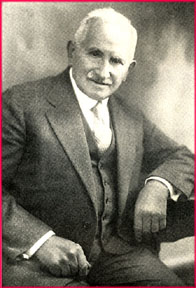
Philip Cowen was born in New York in 1853 and grew up on the Lower East Side. Initially a writer and journalist, he co-founded and became editor of the Conservative Jewish publication American Hebrew, a position he held from 1879 until 1906.
Cowen began working with immigrants on Ellis Island in 1905. President Theodore Roosevelt appointed him Immigration Inspector on the Board of Special Inquiry, which had the power to determine whether applicants were fit to enter the United States. A year later, President Roosevelt asked him to travel to Russia, to find out what was behind the mass migration of Jews to America and to look into the rumors of pogroms. Upon his return to the US, Cowen told the President that the czarist government not only was doing nothing to stop the pogroms, but it actually was encouraging them.
In 1932, Cowen published his autobiography, Memories of an American Jew (New York, The International Press). In it, he wrote that he had chosen to visit Kalarash because it was “typical” of the 639 towns in which there recently had been pogroms. In the excerpt below from his book, Cowen gave a vibrant description of life in Kalarash in the summer of 1906, less than a year after the infamous pogrom. Unfortunately, the photographs of Kalarash published in the book (some of which are reproduced here) were not of good quality. Philip Cowen died in New York in 1943.
Note: Cowen mentions the Bessarabian-born anti-Semite Pavel Krushevan. In 1903, Krushevan first published in the Russian empire the Protocols of the Elders of Zion, an infamous forgery that outlined spurious Jewish plans for world domination. This libelous canard fueled the anti-Semitic activities of the Black Hundreds, the spiritual ancestors of Pamyat and other anti-Semitic groups in modern Russia. See William Korey, Russian Antisemitism, Pamyat, and the Demonology of Zionism.
To see larger views of the photographs, click here.
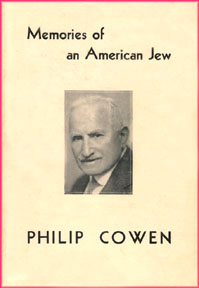
I left Odessa Friday at midnight on a first-class train lit by candles, a solitary one for each compartment. When I awoke we were near Kishinef, and I got up to see what would be my first impression of that place. It was a little after seven when we reached the station. There were but few Jews there, for it was Sabbath morning. Yet I found one to take a note to the leading Jew of the place asking him to meet me at the hotel when I reached there in the evening.
As the train left the depot and the city came into view, I beheld a considerable district covered with low buildings, the churches alone with their uniformly green steeples attaining any height.
Alongside the track were groups of low houses with no roadways, or none that would be considered such. They looked like pigsties or outhouses, but the large number of people moving about satisfied me it was the poorest section of the city, which proved to be the fact. These groups were divided by strong solid picket fences that reminded me of nothing so much as of the familiar pictures of mission houses of military posts in the Indian country built within stockades. The houses were either grass-thatched and moss-grown or the shingles were missing in many places. If these were human habitations, if these were the tents of Israel, and I felt instinctively that they were, then indeed the lives of those who live there are not cast in pleasant places.
Kishinef lost to sight, the rich country round about attracted my attention. Water must indeed by a precious article in that section and hard to get at, for at one place I saw a man at a well drawing it for a large herd of cattle about him. I thought of the story of Rebecca. At another well placed in the centre of a large field, the well [was] the meeting point of four crossroads, [and there] stood a lamp on a pole about eight feet high, as though a guide at night to the natives seeking drink.
At the stations all along the line were piles of sacks containing wheat and corn, while wagon on wagon was passing over the roads with large hogsheads containing the juice of the grape extracted by the growers and being taken by them to market. This is a great grape country. Plums and apricots also grow in abundance, and here and there were drying houses.
As I passed through it Kalarash recalled to me the story of Evangeline. Like the Village of Grand Pre, it "lay in a fruited valley. Vast meadows stretched to the eastward. West and South there were fields of flax, and orchards, and cornfields spreading afar and unfenced o’er the plain. There, in the midst of its farms reposed the Acadian village."
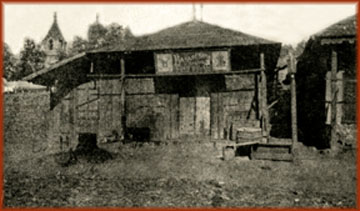
But there the likeness of the picture ended. Perhaps before the days of the pogroms it was an Acadian village, for the remains of some of the houses as you see by the photographs, would indicate the presence of structures that must have made a far different picture than greets the eye of the traveler today.
As in the decadent days of Grand Pre, so in Kalarash then, there were no matrons and maidens with distaffs; and no ".... noisy shuttles with doors mingled their sounds with the whirr of the wheels and the songs of the maidens."
And no wonder. The manufacturer who gave employment to a large number of men and women and who lost 5,000 roubles, was housed in a wooden structure about seven feet high, six feet long, and five feet deep, having no means to rebuild.
As one passed through the unpaved streets [we witnessed] the sight of remains of houses leveled to the ground – one after the other for long stretches, the cellars alone remaining in some places – made the heart sick.
Here was a commnity of 4,560 souls of which 3,960 had been Jews. When I was there the population numbered less than 3,880 though many had drifted in from other pogromed villages. Five hundred and fifty homes, housing 2,000 persons, were destroyed involving a loss of one million roubles. These figures represent the absolute truth. A committee from the Relife Fund and of the local residents took an inventory of every individual loss. It took months to gather, and I saw the records which were prepared with great minuteness. The people who left went to various places. 100 families, representing 500 and odd souls, went to America. Sixteen families, representing sixty persons, had just gone to Canada, and fifteen families, representing fifty-three, to Argentine. Given the funds, half the town would migrate, but the committee allowed only those to go who had a trade.

The Jewish community of Kalarash had always had a large charge upon its bounty. It had its poor that lived in hovels on the hillside: the sanitary conditions were passable simply because of the excellent natural draining of the place. It is true that the mechanics earned good wages, carpenters getting as high as fifty roubles a week, but then they could normally only find work for three months in the year, so that this average wage was but about six dollars. The day laborers got a rouble a day, and the cheapest rent for one room in a shanty with a dirt floor was five roubles or $2.50 a month. But they must have their tea, and in one of the poorest houses I saw a tin kettle set into the masonry of the oven so that hot water for tea was always on tap – if they had the tea. What they do for sugar I could only imagine when the regular price was about ten cents a pound and to the poor who only buy in driblets, about eighteen cents. Sugar in Russia was bounty fed. There was no cheap grade, there: only crystallized white sugar was to be had, that being, I believe, the only product from beets.
Five hundred to six hundred of the people were in the commission business, handling wine, fruit, wheat, beans, corn, etc. The year before had been a wonderful one. That year the harvest, while very large, was poor, because of too much rain.
While agriculture was the staple employment, the Jews were not largely engaged in it, and only about 1`00 of them were wine and small fruit culturists, and made their own wine and dried fruit. There were no public schools, and of the 3,000 children in the place less than 300 had the rudiments of an education. These had private tuition. There were sixty-eight synagogues in the place (of which two had been burnt down) and twenty-five prayer halls.
Of the 350 houses ruined or robbed, 150 had been burnt, all the best among them. Only sixty were being rebuilt, and these on a most modest scale. They were, however, neat specimens of architecture, with their fronts and white marble: the workmanship was first class, reflecting credit on the local mechanics.
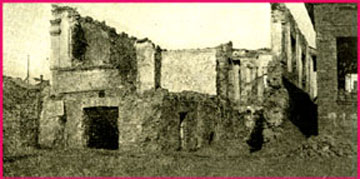
Among the sufferers was a single non-Jew. He was a German who had come to the defence of the Jews and shot at the Hooligans. He was repaid by his house being set afire. It was a large structure worth 10,000 roubles. To judge from the substantial brick foundation left it must have been a remarkably fine building. The Jewish committee helped him with 800 roubles, but the man was ruined and could not rebuild.
In all forty-two persons were killed outright in the pogrom and fifty-three wounded, of whom some died subsequently, while others were so severely wounded as to be incapable of further self-support. Twenty-three were widowed and sixty-eight orphaned.
It was alongside the office of the Ispravnik (police chief) Vostroschin, about 200 feet away, that the plundering started and it continued down that side. When sated with plunder and destruction, the pogromcheks went across the road and then the favoc continued till not a building was left there.
Into the cellars the people crept and there they stayed during the burning and looting, some for two days or more. I cannot tell you the tales of their suffering. The water of the city is to be had only at public pumps. Did they dare venture forth? I cannot tell you what I was told mothers gave their babies in the pangs of thirst while they lay there in the dark, noisome cellars. I went into several of these holes in the ground. They were used to store casks of wine, lumber, etc. By measurement they were quite uniformly eight by nine feet, and about five feet high, moist and dark. There was nothing but the damp, dirty floor to lie on. From this alone many became crippled for life.

Passing along the roads the ruins looked as though a cyclone had passed over one side and merely touched the other. The fact that the Hooligans plundered the best stores that were on one side of the street, and then set fire to the bildings on the other, the poor side,they contented themselves with plundering. What they could not carry away they destroyed. Even a hardware store worth 10,000 roubles was so treated, and an iron dealer’s stock was maliciously broken into junk. The largest dealer in the place lost 100,000 roubles and was only enabled to resume business by a renewal of credit from ealders in Moscow and elsewhere from whom he had purchased for many years. His was the greatest individual loss. The Talmud Torah School, which was also the Bethamedrash, was the oldest building in the district and had been erected over a hundred years ago. It was valued, with its belongings, at 10,000 roubles, not reckoning the antique worth of the contents and hangings for the holy ark. The building was about 150 feet deep and eighty feet wide. The photograph shows it substantial construction and all that is left of it.
Some idea of the disaster may be gleaned from the fact that Dr. Chassileff, who was the Pooh Bah of the community, and was the only available physician – for trains were not allowed to run, nor were even doctors allowed to enter the city – labored almost unintermittently for seventy two hours. The tales he had to tell were fearful: old men brutally handled, young women dishonored under the most horrible conditions, children mangled.
The picture showing all there was left of five substantial houses, tells where seventeen persons were burned to death. Some had escaped to the well-built cellars, where they were found dead after several days.
Who was it did the deed? Surely in a community so exclusively Jewish the few neighbors were not at the bottom of these terrible doings! And remember that this was only one of the 639 pogroms that were raging on the same few days throughout Russia.
The leaders were twenty Hooligans from Kishinef: the willing tools who saw the chance to get all they wanted for nothing, for they had no money to pay for anything. There were 100 of the Moldavian workers on the farms further up the road who came with wagons and tools, all prepared for the work of destruction and to carry off the plunder, for they seemed to know well what part they were to play.
As I saw some of these Moldavians driving up the road with barrels of wine or loads of produce and noted the looks of hate that they cast at every Jew that crossed their path, they seemed to me well calculated for the work set to their hands.
But what of the authorities? Did they not intervene? As I passed along looking for Dr. Chassileff, I head an argument in the town hall across the road,and my informant went to see what was the trouble. They were simply talking over with the police chief, Ispravnik Vostrostchin [sic], the one subject that was still uppermost in the mind of the people, the pogrom of a year ago. Talk of what you will, and the answer will in some way or other be hinged on the pogrom. Everything dates from the pogrom. This officer was still at this post as he was at that time, and he still maintained that he but did his duty as he was directed to. He had no ill will personally against the Jews. When the committee came to him and implored him to stop the mob with soldiery, he said he could not, for the Czar had commanded [sic] to despoil the Jews and he had no power to interfere! And he looked the type of man to really believe such a story. No one suspected for a moment that he personally profited by the incident.
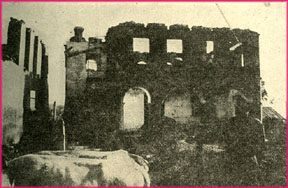
Who told this man – as other officers similarly situated in the vastly scattered territory covered by these 639 pogroms said they were told – that the Jews might be despoiled and murdered: that such were the orders of the Czar? No greater indictment against old Russian can be brought than the undeniable fact that on the same days, in 639 places widely dispersed, the torch of the incendiary and the hand of the thief and the murderer were set against one people, and that in so many cases the authorities when approached to stop their awful work, should make the same answer: "The Czar has commanded it!" It was the work of Krushevan, who was responsible for the story of Kishinef, and his successors, the "League of the Russian People," otherwise known as the Black Hundreds.
"The Czar has commanded it"? When the manifesto was issued the newspaper despatches [sic] stated that its text had not been telegraphed everywhere throughout Russia for some days "for fear of its effect upon the populace"! Thus it was that, while the people everywhere heard that the Czar had issued a decree, its meaning and purpose were unknown to many. This, it was said, was done designedly, the reactionaries giving a twist all their own to the act of the Czar, and one that doubtless justified the pogroms because "The Czar has commanded it!"
I asked in Kalarash, as I did elsewhere, what were the relations of the Christians towards the Jews. I had always heard that deep down in the hearts of the Russian people, — simple folk that they are, there reigned a spirit of concord, of amity, of fraternity, for the Jews. "Yes! Before the first Kishinef pogrom that was the case. We fraternized with our Christian neighbors, we implicitly trusted one another. Outside of religious matters, we were as one. But this is all changed now. The first fearful days of Kishinef marked the change, and those who were responsible for Kishinef were responsible for turning the Russian against the Jew." The same story came to me elsewhere as at Kalarash. At Kishinef, and by people I met in the cars who had hailed from other places, this statement was confirmed.
A good index of the effects of the pogrom is shown by the reports of the community that I obtained. For the year 1905-5 the income from all sources was 8,305 roubles, while for the present year the receipts were just 100 roubles. This was due partly to the unsatisfactory harvest, but most of all to the pogrom, for those who last year gave to their brethren were themselves dependent this year on the gifts of brethren elsewhere.
When the whisper of a pogrom comes now, the people start like hares. When the news came from Bialystok, seven families in Kalarash set out for the United States. When Siedlice was heard from, eight more pulled up stakes. One family had already purchased tickets for Philadelphia to join a brother or son, stayed home when he wrote them of "a progrom they had in Philadelphia," referring to some labor incident there between Jewish and other workers.
"If there are pogroms in America, we might as well die in Russia," the son wrote, announcing his intention of returning home.
As I passed down the road to the depot, chatting by the way with the people who were sitting in the sun of a delightful October day, and repassed the scenes of destruction, I recalled some of the lines of Goldsmith’s "Deserted Village": "Sunk are thy bowers; in shapeless ruin all; And the long grass o’ertops the mouldering wall; And trembling, shrinking from the spoiler’s hand, Far, far away, thy children leave the land."
Yes: that is the story of Kalarash. I did not believe what I was told of it. I believed it later, for with mine own eyes have I seen it.
When I returned to Odessa I saw five families representing twenty-one people from Kalarash who, "trembling, shrinking from the spoiler’s hand", were on the way to the Argentine, the committee largely recommending Argentine and Canada except for those whose families are in the United States. "Thank God," they said to me, "there are noble souls in America, or we would not have these clothes to wear."
Credits: Introductory text and page design copyrighted © 2007 by Helene Kenvin. Page created by Helene Kenvin. All rights reserved.